THE PARSEC, powered by the SUN
Event Location: Cocoa-FL
Competition: Junior Solar Sprint
Division: 7-8 (JSS Blue)
School: Orlando Gifted Academy
Team Name: The Neutrinos
Project Name: The Parsec
Team Size: 3
Event Year: 2025
Event Location: Cocoa, Fl
Competition: Junior Solar Sprint
Division: 7-8 Blue
School: Orlando Gifted Academy
Team Name: The Parsec
Team Members:
Paayal S, 6th Grade
Miles S, 8th Grade
Clay W, 8th Grade
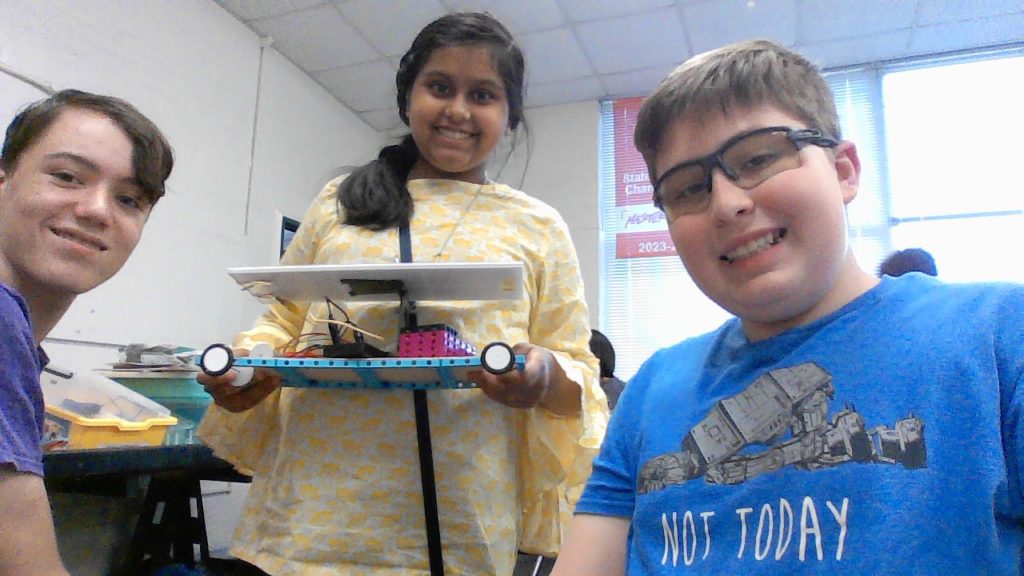
Hello,
We are Solar Electric Vehicle Team from Orlando Gifted Academy presenting our solar racer PARSEC.
OUR GOAL
To design and build a high-performance solar electric race car that is
a. sturdy and innovative.
b. steered by wire and able to safely carry a “passenger”.
c. able to switch to battery power for inclement weather – making it an all-weather car.
d. use as many green energy/ reusable components as possible staying consistent with REFUSE-REDUCE-REUSE-RECYCLE
THE CONCEPT
Solar cars harness energy from the sun by converting it into electricity. The solar panel placed on top of the car captures solar energy and converts it to electrical energy. This electricity fuels the battery that powers the car’s motor. Instead of using a battery, some solar cars direct the power straight to an electric motor like in our model. The motor converts the electrical energy into mechanical energy, which rotates the pinion gear. The pinion gear in turn rotates the spur gear which is mounted on the rear axle, making the rear wheels rotate thereby propelling the car.
OUR DESIGN PROCESS

MATERIALS USED
| Material | Reused/Recycled/Purchased | Price |
| Balsa sheet | Reused | N/A |
| Phone Stand | Purchased | $15.00 |
| Alligator clip wires | Reused | N/A |
| Various Assorted LEGO Pieces | Reused | N/A |
| Solar Sprint Deluxe Kit | Purchased | $41.00 |
| Battery Holder | Purchased | $6.99 |
| Switches | Reused | N/A |
| Superglue | Reused | N/A |
| Ping Pong ball | Reused | N/A |
| Paper Cup | Recycled | N/A |
| Foam board | Reused | N/A |
| Measuring Tape | Reused | N/A |
| Pencil | Reused | N/A |
| Scissors | Reused | N/A |
OUR CAR’S EVOLUTION
| DATE | TIME SPENT | TASK PERFORMED | ISSUES ENCOUNTERED |
| 03/31/25 | 1 hour | Met with our coach to learn about the competition. Collected the kit. Established goals and focus on reusing as many components as possible | None |
| 04/01/25 | 1 hour | We went over the concept of a solar powered car, read the specifications and instructions sheet, talked about and designed our prototype on Paint App (see picture above), estimated the number of times we will meet to complete the project. We inspected the items in the kit, listed the additional material we will need and decided to use as many reusable materials as possible. Our aim is a light weight and efficient car. | None |
| 04/02/25 | 1 hour | We made the base of our car, the chassis. Since the Balsa strip was thin and not very sturdy, we reinforced it with Lego blocks we repurposed from a different project. This also will help add the axle and wheels. Since the solar panel is the most important parts as it powers the car, we decided that we wanted it to pivot so we can move it in the direction of sunlight. | Based on the racer’s performance if the lego pieces are adding weight and creating drag, we might take them off. |
| 04/02/25 | 1 hour | We made the “seat” for the “passenger” with repurposed lego blocks. We worked on the wiring today and completed wiring the battery panel. Then attached it to the chassis. | We might swap out the lego seat for a simpler paper cup if the weight impacts the performance. |
| 04/03/25 | 1 hour | We included the motor and the wheels, positioned and spaced them out so the center of gravity is maintained for a smooth and straight drive. We used: Spur Gear – 60 teeth and Pinion gear – 30 Teeth, for a ratio 2:1 | None |
| 04/04/25 | 1 hour | We worked on the car’s solar electric circuit. We mounted the solar panel to the pivot. We checked to make sure the motor worked on both solar and battery power. | Based on the performance again, we might switch out the cellphone holder that e have currently mounted the solar panel on, to a ball and socket joint. This might be the smart way to account for sunlight from any direction on the day of the competition. |
| 04/05/25 | 1 hour | We started the documentation process based on the pictures and notes. | None |
| 04/06/25 | 1 hour | We attached the guide for the guide wire, tested the car on battery power. | None |
| 04/07/25 | 1 hour | We took pictures, tested the racer on solar power. We also filmed the videos. | None |
| 04/08/25 | 1 hour | We completed the documentation in the website. | None |
PICTURE LOG
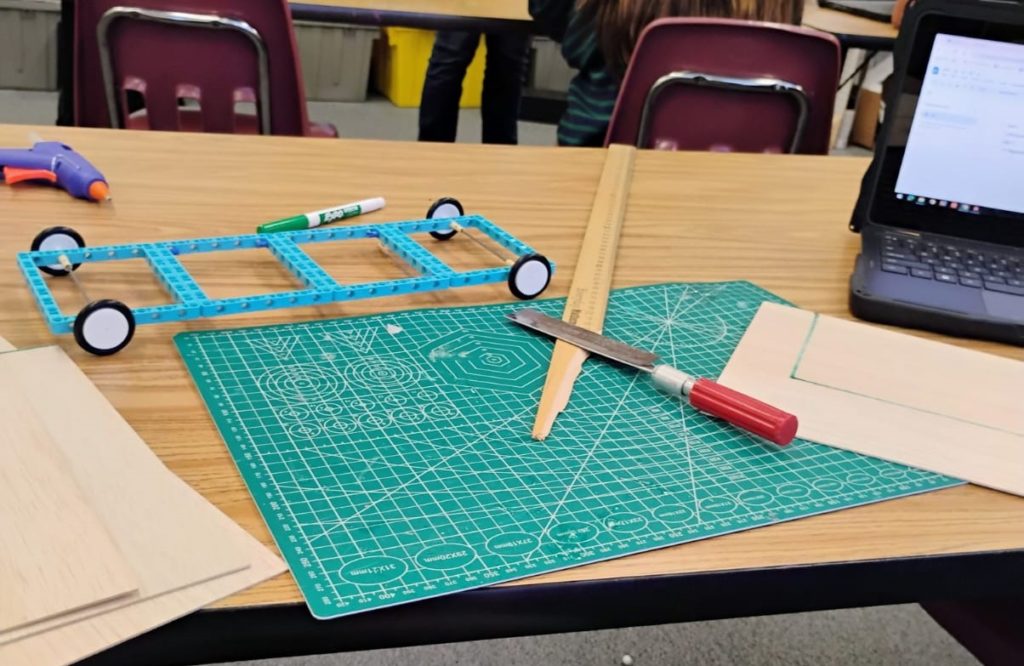
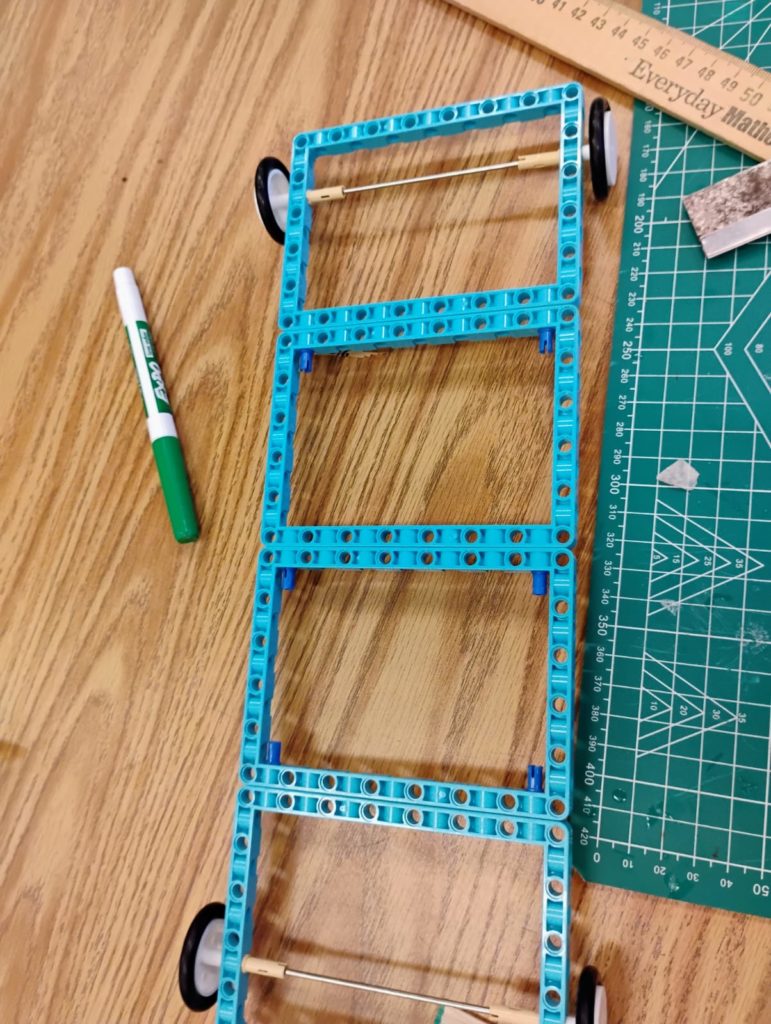
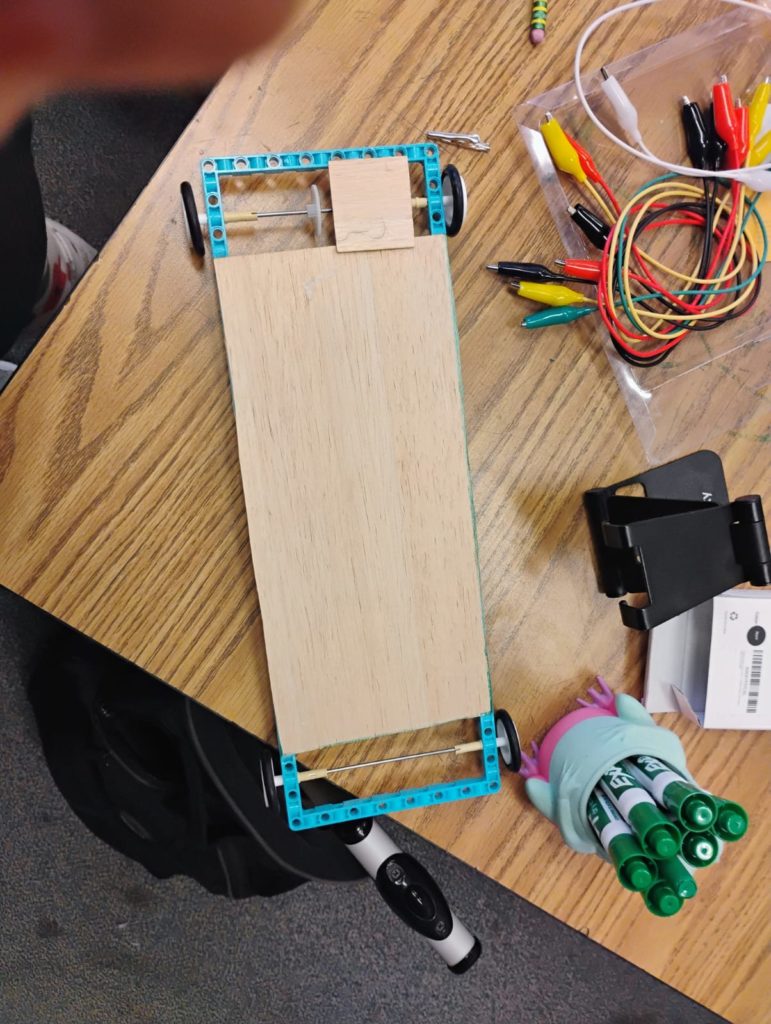
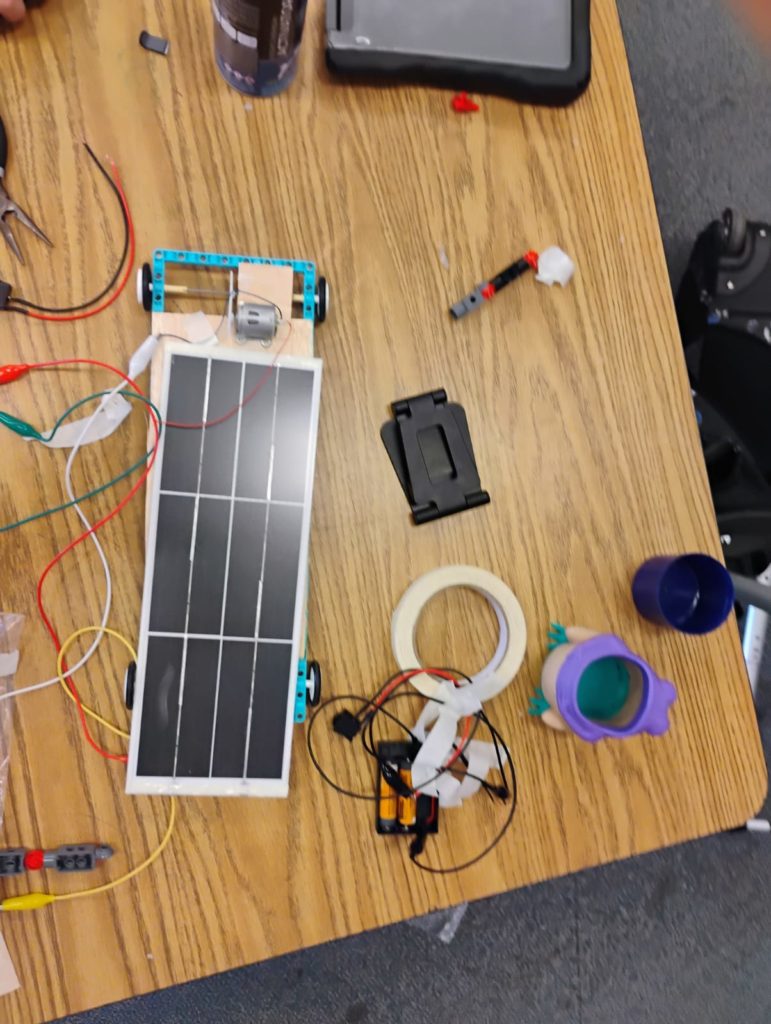
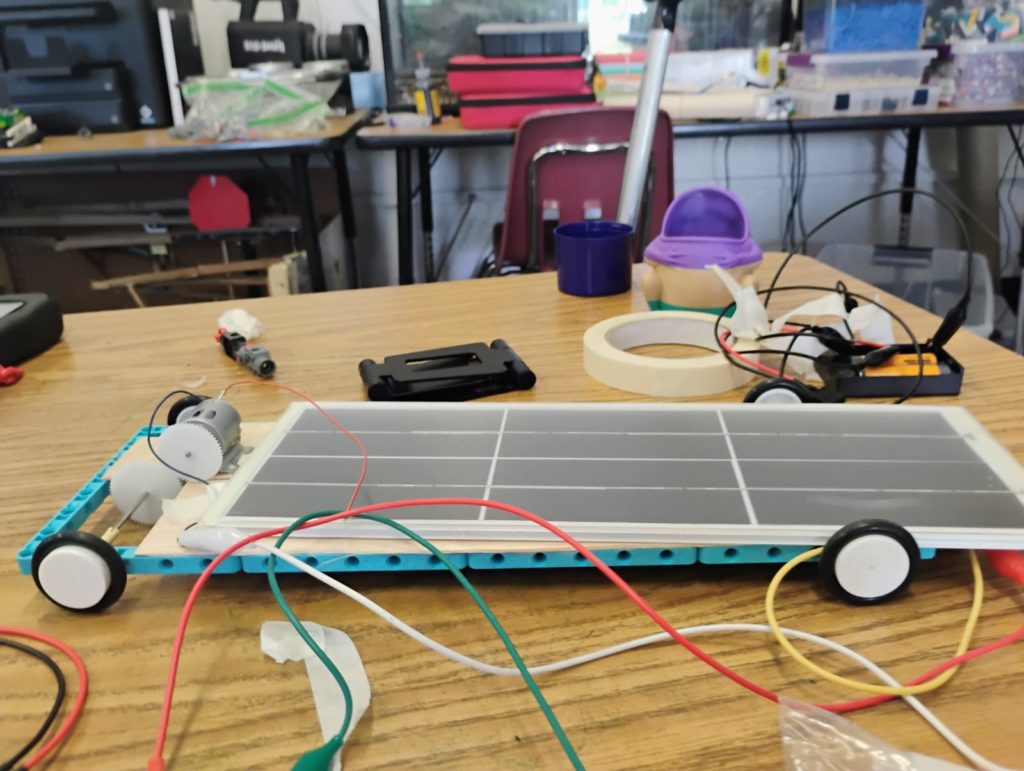

VIDEO DESCRIPTION
FINISHED CAR SPECIFICATIONS
Length: 36 cms
Width: 14 cms
Height: 13.5 cms
Wheels: 4
Front Wheel Diameter: 3.5 cms
Back Wheel Diameter: 3.5 cms
Gear Ratio: 2:1
Weight: 468 gms
Control steering: Monofilament fiber
Chassis: Balsa Wood
Seat: Lego container
Enhancement: Pivoting mechanism for the solar panel to follow the sun for maximum power.
Top Speed: 2.5 m/s(with solar power) / 2.7 m/s(with battery power)
TRIAL RUN RESULTS
| Power Source: Battery Date: 04/06/25 Weather conditions: Cloudy Distance: 20meters Observations: As the batteries discharged we noticed the deceleration. |
| ATTEMPT # | TIME (s) | SPEED (m/s) |
| 1 | 7.29 | 2.74 |
| 2 | 7.39 | 2.70 |
| 3 | 8.04 | 2..48 |
| Power Source: Solar Date: 04/07/25 Weather conditions: Sunny Distance: 20meters Observations: Not using the guided wire for the trial made the racer veer to the left and follow the contours of the road |
| ATTEMPT # | TIME (s) | SPEED (m/s) |
| 1 | 7.77 | 2.57 |
| 2 | 7.66 | 2.61 |
| 3 | 7.93 | 2.52 |
TRIAL RUN VIDEO
GLOSSARY
Speed – Magnitude of change of an object’s position per unit time. It is measured as
Speed = Distance Traveled / Time taken
Rotation speed – is how many rotational events occurred per unit time. It is measured as
Rotational Speed = Rotations / Unit Time
Torque – is how much force is needed to cause an object to rotate about its axis. Just as force causes an object to accelerate during linear motion, torque causes an object to acquire angular acceleration.
Power – It is the mechanical output of the motor. It is measured as
Power = Torque X Rotational Speed
Gear – a rotating circular toothed machine part that meshes with another toothed part to transmit motion or change speed.
Gear Ratio – Ratio of the number of teeth on the two gears that are meshed. In this case, the number of rotations of the pinion gear to the number of rotations of the spur gear.
IN CONCLUSION
Clean energy is crucial for earth’s survival and solar energy is the most consistent and powerful there is. Solar cars are significant for their potential to revolutionize transportation by offering a sustainable, eco-friendly alternative to traditional gasoline-powered vehicles, reducing greenhouse gas emissions, pollution and dependence on fossil fuels thereby mitigating climate change.
The benefits of a Solar car are very many –
1. Environmental Benefits:
a. Reduced Emissions: Solar cars generate zero emissions while driving, contributing to cleaner air and mitigating climate change by
reducing greenhouse gas emissions.
b. Reduced dependence on Fossil fuels: By utilizing solar energy, these vehicles lessen reliance on finite and polluting fossil
fuels, promoting energy independence.
c. Noise Reduction: Solar cars are typically silent, unlike internal combustion engine vehicles, which contributes to a quieter urban
environment.
2. Technological Advancements:
a. Innovation in Solar Technology: The development of solar-powered cars pushes the boundaries of solar technology, leading to more efficient solar panels and improved energy storage systems.
b. Integration of Solar and Electric Technologies:
Solar-powered cars demonstrate the successful integration of solar and electric technologies, paving the way for a more sustainable and efficient transportation system.
c. Longer Lifespan: Solar panel cars are durable and long-lasting, with a lifespan of up to 30 years or more.
3. Economic Benefits
a. Potential for Energy Independence: Solar-powered cars can provide energy independence, allowing owners to generate their own electricity and reduce reliance on traditional energy grids.
b. Cost Savings: Using solar energy to power EVs can lead to significant cost savings by eliminating the need to pay for electricity from the grid. It can provide backup power to your home in the future.
b. Lower Running Costs: Once the initial investment is made, solar cars can significantly reduce transportation costs as they don’t require fuel or oil changes.
This was the biggest motivating factor for us in selecting this project.
We went with a simple yet strong basic design concept of a solar-powered car, it features simple enhancements like the ball socket joint that can maneuver the solar panel 360 degrees. This simple mechanism helps is maximize the solar energy, making the racer more efficient. We also intentionally minimized the weight by removing the unnecessary parts, making it more effective in speed. We have considered ease of use by including a battery holder with an easy switch. These enhancements have enabled the racer to perform consistently in multiple test runs. More importantly, we were very intentional in repurposing as many parts as possible.
IDEAS FOR FUTURE ENHANCEMENTS
We thoroughly enjoyed this attempt at energy efficiency and independence. We will continue to work on future enhancements to build a vehicle that is green energy driven with efficient fuel technologies, one that will work even in minimal sunlight and be cost effective in the long run. Some of the ideas we want to work on next –
a. Decreasing the weight of the car further by testing alternate materials, without impacting the stability of the vehicle.
b. Enhancements for boosting the solar energy with additional reflecting surfaces or even a second solar panel.
c. Using a rechargeable battery for storing the solar energy for later use.
CREDITS
Team PARSEC would like to thank
Our Coach and mentor, Mr. Kyle Dennis
Our parents
Resources: www.khanacademy.com, www.academickids.com, energy.gov
The only difference between science and screwing around is writing it down.” -Adam Savage

Orlando Gifted Academy students looks like are God gifted, very meticulous plan and execution shows the efficacy of the project by the students.
Great effort and team work by Paayal, Clay and Miles.
Keep up the great work!
Good job Paayal, Miles and Clay..!!!
Great project, impressed with the detailed study done on it. Sustainable, eco friendly energy is the way forward.. All the best, Keep going..
Great job, Team PARSEC! All the best👍🏽
Excellent work kiddos!! 👏 👏 I am amazed by the critical thinking and hard work your team has put in. You guys rock..keep it going 🙌 Best wishes for State competition on the 26th!!
Impressive work Team Parsec! Congratulations on an innovative and environmentally friendly design, meticulous report writing and thorough experimentation. Best wishes for a bright future!
Great job Team PARSEC! Your hard work is paying off. Nice detailed report and data. Your use of the engineering design process is evident!